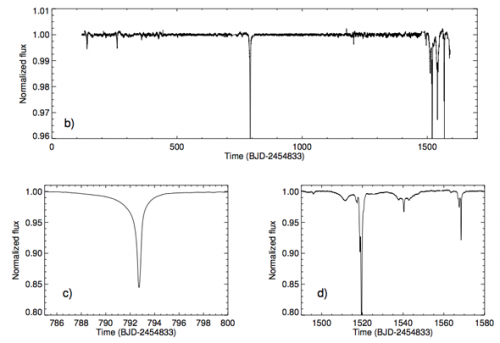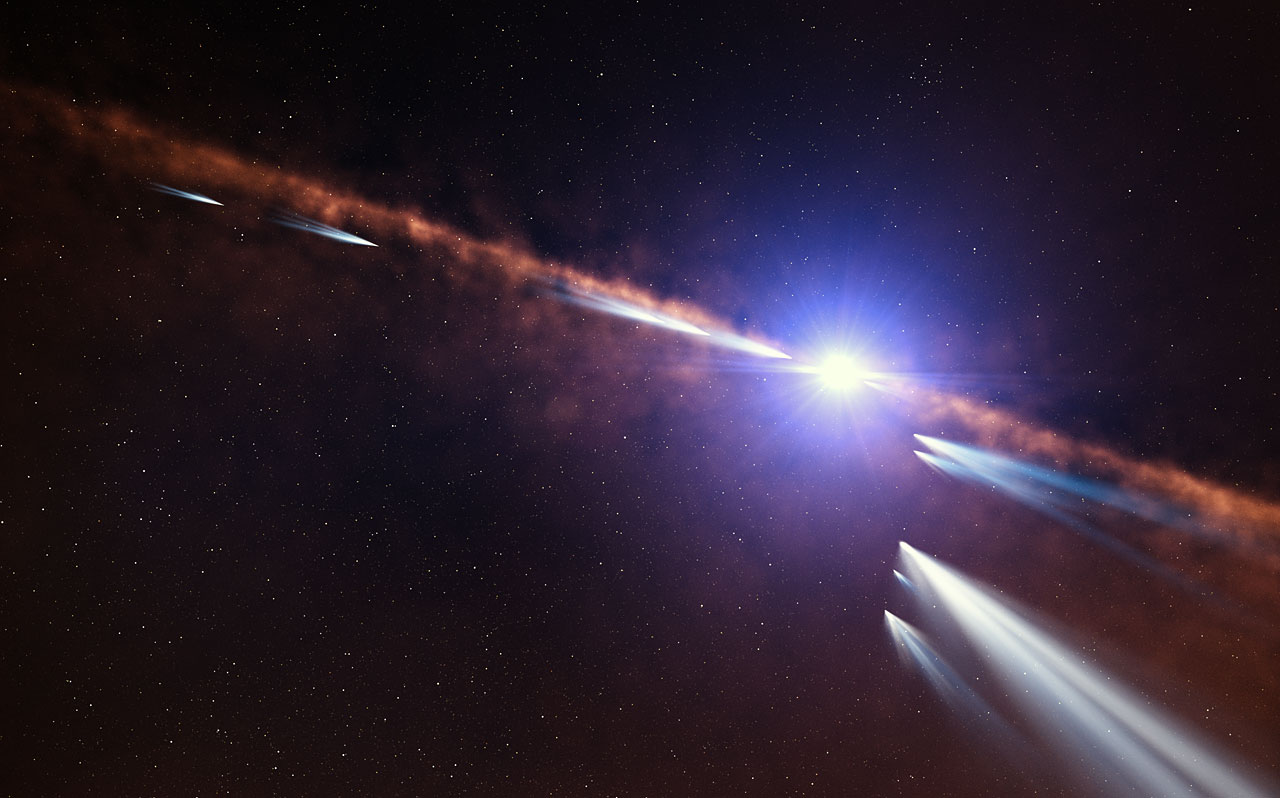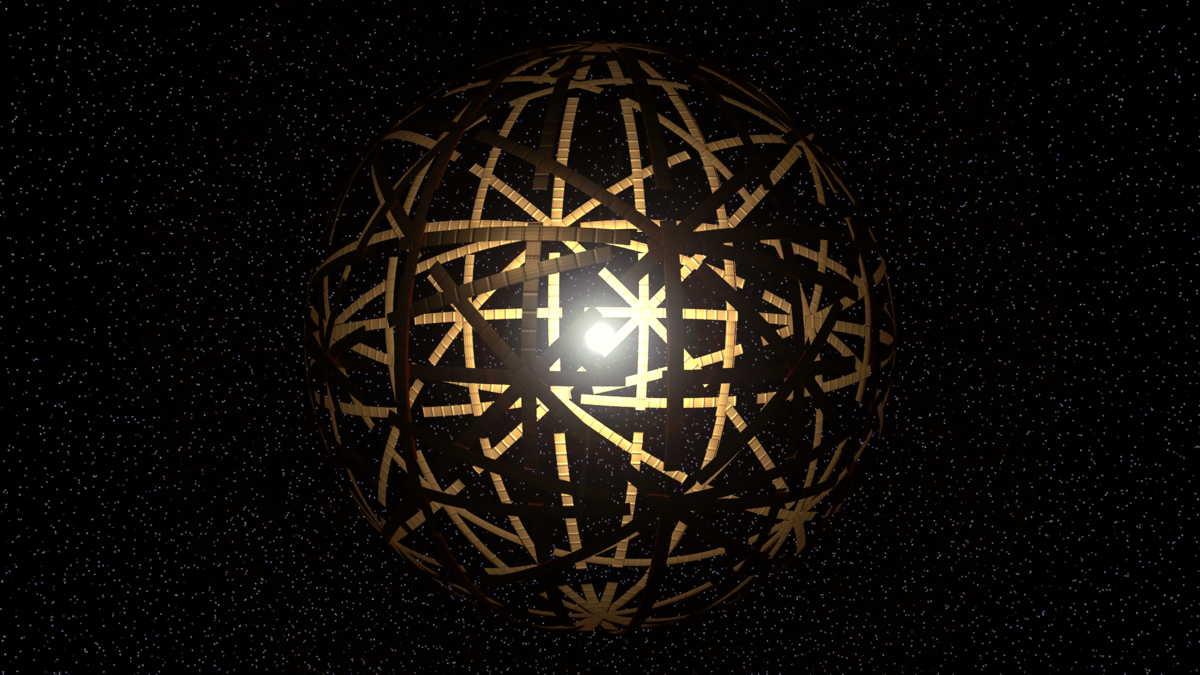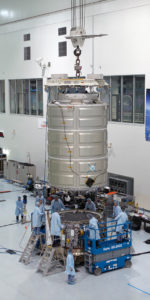
With all the buzz surrounding the discovery by NASA’s Kepler space telescope of the strange and unexpected transit signals in front of the otherwise regular star KIC 8462852, the past week has seen no shortage of excitement for astronomers and space-minded enthusiasts alike. As is most often the case, when mysterious and completely unexpected astrophysical discoveries crop up, aliens tend to be the explanation of choice among the media. Even though at face value this may seem as a silly proposition for many, in the case of KIC 8462852 it remains a credible scientific hypothesis. For that matter, astronomers have begun a close-up study of the inconspicuous star in the hopes of explaining Kepler’s enigmatic observations. To that end, the American Association of Variable Star Observers recently issued a call to the astronomical community worldwide for more detailed observations, while the SETI Institute has began searching for possible radio signals of artificial origin in KIC 8462852’s vicinity.
Kepler’s observations of KIC 8462852 have certainly been the most unique of the space telescope’s entire mission to date. While the bulk of Kepler’s exoplanet discoveries have been characterised by the detection of predictable and well-defined, U-shaped light curves whenever planets happen to cross the face of their host star across the telescope’s field of view, KIC 8462852 has been the notable exception. The latter exhibits light curves which are completely asymmetric and chaotic, showing no sign of periodicity or symmetry. Furthermore, whereas gas giant exoplanets typically block no more than 1 percent of their host star’s light as they pass in front of them, the dips in starlight that were observed in the case of KIC 8462852 varied up to a whopping 22 percent. This data indicates that there’s something huge that passes in front of KIC 8462852 at irregular intervals, but what?

Here’s where all the fun begins, with scientists proposing several different scenarios to account for these observations, but almost every one of them pose several problems. If what is crossing in front of KIC 8462852 is indeed a planet, then why doesn’t its transit exhibit the regular U-shaped light curve like the thousands of other exoplanets that have been discovered to date? More importantly, why does it block such a relatively large percent of its star’s light in the process? If the observed mass in front of the star is a huge circumstellar dust disk, possibly created by devastating collisions by any unseen orbiting planets, then where’s the excess emission in mid-infrared wavelengths that is naturally associated with such formations, as has been observed around a multitude of other stars that do host such disks?
The most plausible explanation that also fits the data, according to the science team that made the discovery, seems to be the presence of a vast belt of comets around KIC 8462852. If that is indeed the case, it would certainly help to explain the randomness of the dips in the light curves observed by Kepler. And even though a vast zone of cometary debris should be also visible in infrared wavelengths, it would radiate much less infrared light compared to a circumstellar dust disk. Vast belts of cometary fragments around other stars is nothing unusual, with such structures having already been observed in the past in several different star systems. Our own Solar System is also believed to be surrounded by such a structure, called the Oort Cloud, possibly containing many trillions of comets. In addition, a small companion star just 885 Astronomical Units away from KIC 8462852, whose presence was confirmed by the 10-m Keck II telescope in Hawaii, could well gravitationally disrupt any surrounding cometary belt, causing huge swarms of comets to fall inward toward KIC 8462852.
Yet, the case is far from settled. One of the more fascinating hypotheses that have also been entertained by several scientists is that what Kepler has observed around KIC 8462852 is caused by nothing other than a huge number of artificial structures like solar panels, or even a Dyson sphere, that were built by an advanced extraterrestrial civilisation for generating power. As outlandish as that may seem at first, such a prospect is based on sound scientific principles. Even though the engineering involved in the construction of such artifacts by far exceeds the technological capabilities of our civilisation today, that doesn’t mean that an advanced extraterrestrial one could not build them. And save for the absence of much excess infrared radiation around KIC 8462852 (infrared radiation is expected to be emitted in considerable amounts by large artificial structures like Dyson spheres), the star’s observed light curves are also consistent with the presence of such extraterrestrial artifacts.
The search for just such artifacts has in fact become the subject of serious scientific research in recent years, with many astronomers now proposing ways on how we could discover them around other stars. Such a search is also advocated by Dr. Jason Wright, an assistant professor of astronomy and astrophysics at Penn State University, who has been fascinated by the recent Kepler findings regarding KIC 8462852. “We have in KIC 8462 a system with all of the hallmarks of a Dyson swarm: aperiodic events of almost arbitrary depth, duration, and complexity,” comments Wright in a preprint paper submitted for publication at The Astrophysical Journal. “Historically, targeted SETI has followed a reasonable strategy of spending its most intense efforts on the most promising targets. Given this object’s qualitative uniqueness, given that even contrived natural explanations appear inadequate, and given predictions that Kepler would be able to detect large alien megastructures via anomalies like these, we feel is the most promising stellar SETI target discovered to date. We suggest that KIC 8462 warrants signifi cant interest from SETI in addition to traditional astrophysical study, and that searches for similar, less obvious objects in the Kepler data set are a compelling exercise.”

The Search for Extraterrestrial Intelligence, or SETI for short, is the collective scientific field of study that searches for signs of other intelligent life in the Universe. Spanning a history of more than 50 years, SETI has undertaken many projects since 1960, mainly through the use of radio telescopes, in order to search for any radio signals of artificial origin that might be pointed toward Earth. Even though this effort has proved to be fruitless to date, SETI has nevertheless managed, while having to overcome considerable challenges along the way, to move the prospect of intelligent life in the Universe from the realm of science fiction and fantasy to that of serious scientific research and discussion, transforming it from “fringe” science to a mainstream topic.
As was to be expected, the SETI Institute, which is the leading co-ordinator of SETI projects and relevant research, was quick to answer the call. As was announced at the Institute’s website earlier this week, scientists involved with SETI have started to eavesdrop on KIC 8462852 utilising the Allen Telescope Array that is located at Mountain View, Calif. Comprised of a total of 42 radio dishes, the Array can instantaneously cover the full range of frequencies from 0.5 to 11.2 Gigahertz in the search for any extraterrestrial radio signals that could be originating from KIC 8462852 and be artificial in nature. “Since October 16, the SETI institute has been using its Allen Telescope Array to observe KIC 846 2852 over a wide range of radio frequencies (1 to 10 GHz), looking for any artificial signals,” writes Seth Shostak, Senior Astronomer at the SETI Institute. “We’re continuing to analyze the data. In another week, our SETI team will once again observe KIC 846 2852 using some new receivers being affixed to the Allen Array – known as Antonio feeds – that will increase the sensitivity by a factor of two.”
As fascinating as this search is, every scientist involved is aware of the astronomical odds against receiving such a signal in such a short timescale. Even if extraterrestrial civilizations do exist out there, and even if they’re trying to specifically contact us out of the billions of others stars in the galaxy, it has been argued that the infinity of cosmic time prohibits such a communication from taking place. We may be too early or too late in the scene and other civilizations have moved on to using different means of communication that we can’t even begin to imagine. Nevertheless, the nature of real scientific inquiry demands that we do try, whatever the outcome. “One shouldn’t let healthy skepticism degrade into unattractive pig-headedness, even if in this case the evidence for something revolutionary isn’t terribly promising,” adds Shostak. “You have to follow-up. And we are.”

Even in the case that SETI comes up empty, the study of KIC 8462852 is still worthwhile and attractive from an astrophysical point of view. As the initial findings from Kepler have showcased, many of the star’s properties are still wrapped up in enigma. More specifically, even though KIC 8462852 is generally believed to be of a mature age, some astronomers aren’t quite convinced. “If I had to guess I’d say the star is young, despite all appearances,” comments Wright. “I can’t back that up.”
The issue of KIC 8462852’s age is important, for a younger age would mean that the star is more active and more variable in nature, which in turn would indicate that the unusual light curves that were observed by Kepler would most probably be caused by natural astrophysical processes on the star itself. For this reason, KIC 8462852 has also become the subject of study of the American Association of Variable Star Observers, or AAVSO for short. With the goal of gathering as much detailed photometric data as possible, AAVSO recently issued a call to amateur astronomers worldwide for obsrving KIC 8462852 at least through early 2016.
“[KIC 8462852] is not known to be a close binary or a young stellar object, and there are no other typical indicators of circumstellar material such as infrared emission, writes AAVSO’s website. “More observations are requested to further characterize the star’s variability … The star itself is also rotating, and shows rotational variation at the millimagnitude level with a period of 0.8797 day. Instrumental observers world-wide are encouraged to participate, and we encourage observers from Asia and the northern Pacific especially to participate to improve temporal coverage of this star.”
This intensive follow-up study of KIC 8462852 is a good example of keeping up with the true spirit of science, which is to openly approach the unknown with an open mind and at the same time an utter respect to fact and observation. No matter how far-fetched or ludicrous a scientific hypothesis may seem, it should be examined with openness and scepticism both. This approach is solely sadly missing today by a large percentage of the media and the public at large, which almost always tend to be carried away by unfounded speculation when it comes to new and unexplained cosmic mysteries. “Invoking alien engineering to explain an anomalous astronomical phenomenon can be a perilous approach to science because it can lead to an “aliens of the gaps” fallacy and unfalsifiable hypotheses,” concludes Wright in his study. “The conservative approach is therefore to initially ascribe all anomalies to natural sources, and only entertain the extraterrestrial intelligent hypothesis in cases where even the most contrived natural explanations fail to adequately explain the data.”
Whatever the reasons behind KIC 8462852’s anomalous light curves may be, we’re bound to learn something new and exciting. If that turns out to be an astrophysical process that we were previously unaware of, it will teach us something new about stars that we didn’t know before. And if it turns out to be, well, something else, so much the better!
It will all be a win-win situation, either way.
Be sure to “Like” AmericaSpace on Facebook and follow us on Twitter: @AmericaSpace
.





Been to the SETI antennae field in Hat Creek- I stopped and visited on a paragliding trip to Hat Creek rim many years ago.
At hat creek rim the black volcanic rock soaks up the sun all day and at sunset all that heat rises in a huge column of smooth as silk lift that lasts about 40 minutes to an hour. In hang glider and paraglider slang it is called a “glass off.” I never experienced such perfectly smooth yet powerful lift anywhere else- I just kept going up and up. I wonder if I will ever make it out that way and fly there again.
Amazing Story
Paraglider pilots practice “kiting” their “wings” because some launches off cliffs and mountains require it be overhead, fully inflated, and under precise control before taking off- or you will die. I used to go out to the beach in Alameda California and practice and people would always, without fail, walk up to me and ask me, “why don’t you take off?” So I also learned how to explain how a glider is a gravity powered aircraft and is always flying downward through the air- and when people see a glider maintaining altitude or climbing it is because the air around them is going up faster than they are gliding downward.
In the same way very few people understand some basic facts about spaceflight and are thus taken advantage of, misled, and misinformed about many aspects of our space program. Over the last five years or so it has become apparent to me the public really needs some of these most basic aspects of space and space travel explained to them in terms they understand. Unfortunately scientists and engineers are probably the worst people at doing this.
Until the public gets some kind of collective awareness concerning the realities of spaceflight then the current infomercials about commercial space and Mars will continue to be used to bamboozle and deceive.
Another jewel, Leonidas! ShostAK is right. We cannot dismiss the potential of KC8462852. Examine and study this object we must and continue searching. We will eventually find something out there above and beyond simple extra-terrestrial microbial life.
I can’t read this because the font’s too small! Very dissappinted.
A great and very balanced piece, Leonidas! While we certainly need to take a closer look at this star to find an explanation for the unusual light curve, my money is that it is being caused by comets or debris in the system or some other mundane natural phenomenon.
” … my money is that it is being caused by comets or debris in the system or some other mundane natural phenomenon.”
That would certainly be the smart money bet.
But If you made that bet; wouldn’t you love to lose it.
Mundane seems to be the hope of several people who just have to be the smartest guys in the room. Mundane is as mundane does.
Absolutely, Joe!
It is an instrument failure. The two big anomalies, and the first small one, all occur immediately after the telescope has been turned in the same way. It was turned 4 times per orbit to keep its shield towards the Sun. The anomalies occurring exactly every second orbit is not a coincident, it is just the same bad pixel being turned to the same star. The last anomaly is more erratic because the reaction wheel was failing gradually, moving the bad pixel in and out of the star. It has nothing to do with anything astrophysical. The idea that comets would cover 22% of that big F3 star is pretty ridiculous. But SETI might look at this star as well as at any other. It is no less likely the home of aliens than any other star is, just because a telescope obviously has a slight defect.
Since the signal is not recuring, whatever cauces the dip in the suns light, does not neccesarily need to be a part of that solar system. It could be any type of debree betwin us and that solar system. Or did I miss the information that without doubt fixes it to that solar system?
It is recurring, exactly every other orbit of the telescope around the Sun. So it is an instrument failure.
‘Woldwide’ They are examining this star from Stow on the Wold in Britain then? Spelling is so awful nowadays on the internet.
Wow huge fan of astronomy
Getting real… I thought the Kepler team said that the data anomalie was not hardware related. Or am i mistaken?
@Jerry
Yes they said so. They published it!
But they failed to address the fact that teach anomaly occurred right after the telescope had been oriented the same way. Their exclusion of several kinds of error sources is very well done. But their conclusion that there wasn’t any other error source is too far reaching. They didn’t consider all possible failure modes.
It is obviously an artefact of an instrument failure. Or however would the orbital period of the telescope have any relationship with this F3 star 1500 light years away? Just too much of a coincidence, and no credible astrophysical explanation to compete with it. Next time these guys cry wolf, people might put a deaf ear to it. That’s unnecessary.
Fortunately, brightness changes on the order of 20% are easily observed using ground-based equipment. The Kepler observations for this star could be independently confirmed (or refuted!) in a matter of months.
A Dyson’s Sphere could be – and probably would be – constructed of energy fields – not matter – and therefor the argument that a structure so large would have gravitational/stability problems and the mass would be too much for a civilization to accumulate become moot.